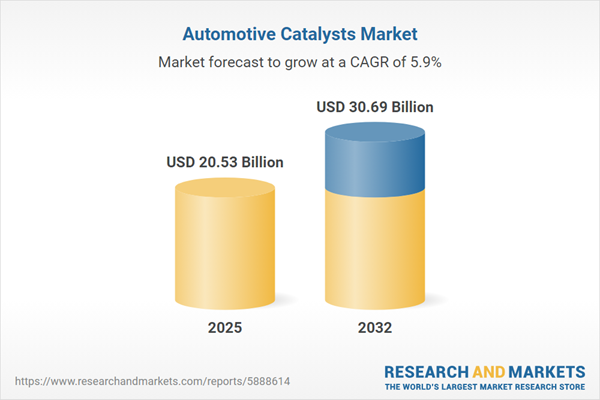Speak directly to the analyst to clarify any post sales queries you may have.
The automotive catalysts market is experiencing pivotal evolution, driven by regulatory momentum, ongoing advancements in emissions technology, and heightened supply chain complexity. Senior leaders navigating this change require informed, forward-looking strategies to sustain growth and compliance.
Market Snapshot: Global Automotive Catalysts Market Growth
The global automotive catalysts market is projected to expand from USD 19.39 billion in 2024 to USD 20.53 billion by 2025, with expectations to reach USD 30.69 billion by 2032. This equates to a compound annual growth rate (CAGR) of 5.90%. Growth within this sector is fueled by stricter environmental policies, improving technologies for vehicle emissions, and enlarged regulatory oversight that influences all major automotive territories. Manufacturers have prioritized innovation in response, with increased focus on research and development to address evolving legislation. In parallel, executive teams are adapting supply chain models and tailoring product development to safeguard competitive positioning and meet emerging operational requirements.
Scope & Segmentation for Senior Automotive Executives
This in-depth report delivers decision-ready segmentation and analytic insights tailored to executives charged with orchestrating market moves, technology roadmaps, and supply strategies in the automotive catalysts space. By clarifying the entire value chain, leaders can confidently align operational planning and strategic compliance to sustain long-term competitiveness.
- End Users: Includes both original equipment manufacturers (OEMs) and aftermarket enterprises, supporting initiatives for process efficiency, regulatory harmonization, and maximizing catalyst lifecycle outcomes.
- Material Types: Covers ceramic and metallic substrates, evaluating their durability, flexibility, and fit for a range of operational or compliance requirements.
- Vehicle Types: Studies heavy-duty, commercial, sedan, hatchback, SUV, and multipurpose vehicles, powering data-driven compliance and go-to-market strategies.
- Fuel Types: Assesses use across diesel, gasoline, hybrid, battery electric, and fuel cell vehicles, contextualizing product planning to global and regional propulsion trends.
- Emission Standards: Provides guidance for positioning with Euro V, Euro VI, and additional regional requirements to inform proactive risk management and technology investment decisions.
- Technology: Examines diesel oxidation catalysts, particulate filters, selective catalytic reduction, and three-way catalysts, enabling leaders to shape differentiated product and regional market offers.
- Regional Analysis: Outlines supply chain development, technology readiness, and manufacturing models for the Americas, EMEA, and Asia-Pacific, aiding regionalized operational approaches.
- Company Coverage: Contains up-to-date benchmarks and strategic assessments of industry leaders like Johnson Matthey PLC, BASF SE, and Umicore SA, to fine-tune competitive stance and guide partnership choices.
Key Takeaways for Strategic Automotive Catalysts Leaders
- Manufacturers are scaling their research and production frameworks to deliver customized solutions and support rapid adaptation to new regulatory demands worldwide.
- Transitioning to electrified and hybrid vehicle fleets brings revised requirements, driving suppliers to offer sustainable and adaptable product designs for both OEM and aftermarket segments.
- Supply chain leaders are diversifying their sourcing models, enhancing circularity through recycling practices, and fostering strong supplier alliances to stabilize input costs and strengthen resilience.
- Effective collaboration between OEMs and aftermarket providers is increasingly essential to navigate evolving compliance challenges and leverage new market opportunities through shared insights.
- The rise of circular economy principles—including advanced lifecycle management and flexible leasing initiatives—shapes strategies for achieving sustainability targets and unlocking new value streams.
Tariff Impact and Adaptive Supply Chain Strategies
Forthcoming US tariffs on imported catalyst materials set for 2025 are reshaping sourcing and production frameworks. Executives are shifting manufacturing operations nearer to assembly sites to reinforce supply chain reliability and foster deeper engagement with local suppliers. This movement towards consolidation supports vertical integration, stimulates co-creation with partners, and strengthens the capacity to navigate market and regulatory uncertainty.
Methodology & Data Sources
Findings in this study are built on executive interviews, targeted industry surveys, comprehensive financial analysis, and meticulous regulatory review. This mixed-method approach yields robust intelligence and multi-scenario planning support for leaders in the automotive catalysts industry.
Why This Report Matters
- Aligns executive strategies and resource allocation with emerging regulatory and technological pathways across the automotive catalysts industry.
- Enables operational teams to swiftly adapt to shifting global and regional priorities by leveraging detailed benchmarks and strategic management models.
- Supports constant improvement of supply chain and sustainability compliance through practical guidance for navigating increasingly complex regulation.
Conclusion
Senior automotive executives benefit from an actionable, structured perspective to respond to ongoing market changes. This report equips decision-makers to strengthen resilience and advance competitiveness in a dynamic global landscape.
Additional Product Information:
- Purchase of this report includes 1 year online access with quarterly updates.
- This report can be updated on request. Please contact our Customer Experience team using the Ask a Question widget on our website.
Table of Contents
3. Executive Summary
4. Market Overview
7. Cumulative Impact of Artificial Intelligence 2025
Companies Mentioned
The companies profiled in this Automotive Catalysts market report include:- Johnson Matthey PLC
- BASF SE
- Umicore SA
- Tenneco Inc.
- Clariant AG
- Heraeus Holding GmbH
- DENSO Corporation
- Faurecia SE
- Eberspächer Group GmbH & Co. KG
- Cataler Co., Ltd.
Table Information
| Report Attribute | Details |
|---|---|
| No. of Pages | 191 |
| Published | October 2025 |
| Forecast Period | 2025 - 2032 |
| Estimated Market Value ( USD | $ 20.53 Billion |
| Forecasted Market Value ( USD | $ 30.69 Billion |
| Compound Annual Growth Rate | 5.9% |
| Regions Covered | Global |
| No. of Companies Mentioned | 11 |









